| Anchor--In early Christianity, the anchor was used as
a disguised cross. Another meaning is that Christ is the anchor which keeps us from
drifting from the proper path. A broken chain on the anchor may represent the end of
earthly life. [1] An anchor combined with an X, the Greek letter Chi, is a sign of hope in
Christ. [2] One example of an anchor is found on the H.T. Budge (1883) monument in block F
of the Original Section. The
stone of a World War II naval veteran in block one of the Sunny Slope addition is an
example of the anchor being used to represent that the deceased had served in the Navy. [3] |
|
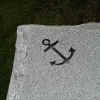
|
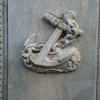
|
anchor |
anchor |
|
| Book-- A book usually depicts the Bible, believed by Christians to
be the Eternal Word of God. The Bible, along with hands, is the most common symbol found
in eighteenth and nineteenth century cemeteries. [4] This is because the Word, contained
within the Bible, is central to Protestant faith. The grave of Demsey Overman (1878),
located in block C of the Original Section, is one example. |
|
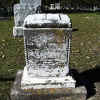
|
Demsey Overman |
|
Broken column--The only example of this design found in Greenwood
is the Charles Collins marker (1854) located in block C of the Original Section. Usually
it symbolizes a life cut short. It also represents the eventual ruin or decomposition of
us all. [5]
|
|
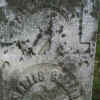
|
Charles Collins |
|
Chalice--The chalice is used by some Christian churches (such as
Roman Catholic and Lutheran churches) to hold wine for Holy Communion. During Holy
Communion, the congregation partakes of bread and wine as Jesus' disciples did at
the Last
Supper. [6] The Burke monument (c. 1894) in the west end of the First Addition contains an
example.
|
|
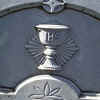
|
Chalice |
|
Cross--The cross is the predominant symbol of Christianity. It
represents the cross that Jesus died on and "serves as an everlasting sign of
God’s suffering, love, and plan of redemption." [7] Examples in Greenwood include
the Morris monument in block G of the Original Section, and a twentieth century example in
block A of the Woodlawn Addition.
|
|
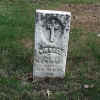
|
Morris Monument |
|
Crown--The crown symbolizes Christian righteousness and heavenly
reward. [8] The John Hewitt stone (1903) in block J of the Original Section is an
example.
|
|

|
John Hewitt |
|
Crucifix--The crucifix, used primarily by Catholics, is an image of
Jesus hanging on the cross. It represents Christ’s suffering and death. [9] The Burke
monument (c. 1894), in the west end of the First Addition, is topped by a crucifix.
|
|
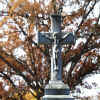
|
Crucifix |
|







